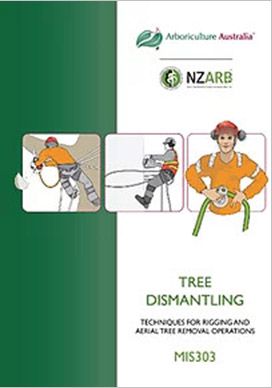
MIS303 Tree Dismantling
MIS303 Tree Dismantling - 2nd ed.
Minimum Industry Standard series Members Price is for Members of The New Zealand Arboricultural Association (NZARB). The vision of NZ Arb is to represent the arboriculture community and make it the primary organisation for tree care and to maintain relevancy to the Association’s members, so if you are in the NZ tree care industry please consider joining NZARB by clicking the link above if you are not already a member. |
This book is one in a series of Minimum Industry Standards produced by Arboriculture Australia Ltd and the New Zealand Arboricultural Association in consultation with the national arboriculture community in both countries. These industry peer-reviewed documents provide a ‘body of knowledge’ which is shared by practitioners and can be used as the basis for training, dissemination of skills and professional development.
This standard covers the basics of tree dismantling, including rigging techniques, the use of a chainsaw in trees, and some fundamental concepts of rigging forces and rigging system design.
Information on equipment inspection, site setup, pre-start checks, tree inspection, rope use, knot tying, the operation of chainsaws, tree felling and tree access is contained within the appropriate MISs for those work tasks.
Contents:
1: Preparing for tree removal
Arriving on site
Preparing to remove trees – site setup Tree removal strategies Tree inspection for dismantling
Basic rigging concepts
Selecting and inspecting rigging equipment
Aerial rigging systems
Rigging equipment configuration and proper use
Designing a rigging system
Introduction to forces in rigging
2: Dismantling trees
Communication during tree work
Using a chainsaw in trees Cut sequences and techniques – branches Straight back cut
Cut sequences and techniques – tree heads and timber
| Falling techniques for tree dismantling – use of wedges and taglines Rigging operations Rigging attachment point: cut and behaviour
Rope control during rigging operations Rope control: rope brakes and friction management
Returning rigging components Specific rigging techniques Natural crotch rigging Applying friction at the point of cut
Snatching Minimising peak force in negative rigging
Bracing a rigging point Floating anchors: highlines and multiple point floating anchors Speed line or zip line Running anchor rigging
Lifting systems Guying a tree
3: Completing tree removal
Completion of works Appendix A: Rigging system diagrams Positive rigging systems
Negative rigging systems
Appendix B: Working the angles Introduction to forces
|
Minimum Industry Standards
The Minimum Industry Standard series is dedicated to all our fellow workers who have lost their lives or have been permanently injured working in the arboriculture and vegetation management industries.
The Minimum Industry Standards project is an Arboriculture Australia led initiative that the NZ Arb is pleased and proud to be involved with. Having joined the programme, NZ Arb works alongside Arboriculture Australia to develop these Minimum Industry Standards. Each Minimum Industry Standard (MIS) provides the key knowledge that is necessary to perform the work task.
| Dimensions | 150 x 210 mm |
| Pages | 222 |
| Cover | Soft Cover |
| Binding | Wire-O |
